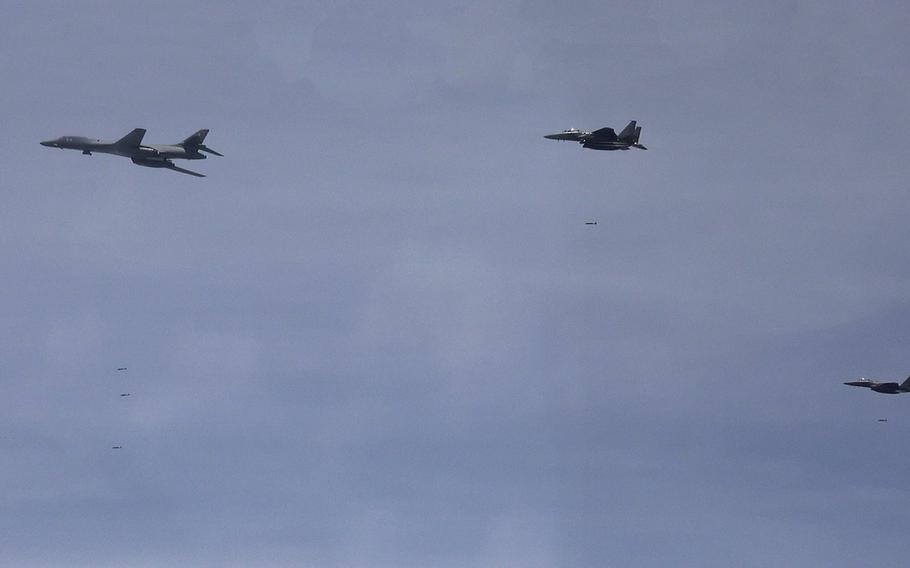
An Air Force B-1B Lancer, left, drops joint direct attack munitions alongside South Korean F-15K Slam Eagles over South Korea, Wednesday, June 5, 2024. (South Korean Ministry of National Defense)
CAMP HUMPHREYS, South Korea — A B-1B Lancer bomber made a live-fire demonstration over the South’s airspace for the first time in seven years, the Air Force announced Wednesday.
The Lancer flew alongside two South Korean F-15K Slam Eagles, F-35A Lightning IIs and KF-16s, 7th Air Force said in a news release Wednesday. They were joined by Marine Corps F-35Bs and Air Force F-16 Fighting Falcons.
The Lancer and South Korean aircraft dropped 500-pound joint direct attack munitions, or JDAMs, at simulated targets on Pilsung Range, about 100 miles southeast of Seoul, according to the command.
The drill maintains Seoul and Washington’s deterrence capabilities against Pyongyang and illustrates their willingness to “immediately … punish any North Korean provocation,” South Korea’s Ministry of National Defense said in a separate release Wednesday.
The Lancer flew out of Andersen Air Force Base, Guam, as part of the service’s ongoing bomber task force missions intended to project U.S. airpower across the region. It’s assigned to the 37th Expeditionary Bomb Squadron at Ellsworth Air Force Base, S.D., 7th Air Force said.
The live-fire drill marked the second appearance by U.S. bombers over South Korea so far this year. Two B-52H Stratofortresses were escorted by South Korean and Japanese fighter jets near the South’s Jeju Island on April 2.
Lancers last flew over South Korea on Dec. 20 during training alongside South Korean and Japanese jets east of Jeju. The show of force, held three days after North Korea fired a solid-fuel Hwasong-18 intercontinental ballistic missile, demonstrated the three nations’ “strong will and capability to jointly respond” to North Korea’s missile threats, the South’s military said.
Defense chiefs from the United States, South Korea and Japan met Sunday in Singapore to discuss security concerns from the North. The U.S. “reaffirmed its ironclad commitment to the defense of Japan and [South Korea], emphasizing its commitment is backed by the full range of U.S. capabilities, including conventional and nuclear,” the Defense Department said in a statement after the meeting.
Wednesday’s sortie comes nearly a week after North Korea fired a barrage of short-range missiles toward the Sea of Japan, also known as the East Sea. The weapons flew roughly 217 miles before splashing down and marked the sixth separate day of ballistic missile testing so far this year by the communist regime.
On Tuesday, South Korea announced it would totally suspend a military deconfliction agreement with the North. South Korean deputy policy minister Cho Chang-rae said the Comprehensive Military Agreement, a pact that established no-fly zones and prohibited artillery drills near the Demilitarized Zone since 2018, will be suspended “until mutual trust between the South and the North is restored.”
Seoul said its decision was prompted by North Korea launching a military spy satellite on May 27 and sending 980 balloons carrying trash and manure over its southern border last week.